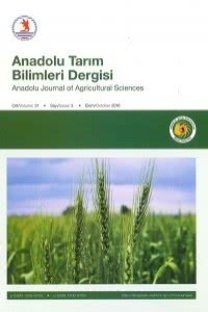Değişik ekim zamanları ve fideleme yönteminin şeker pancarı (Beta vulgaris L.) çeşitleri üzerinde etkileri
Bu çalışma; 1991 ve 1992 yıllarında Bafra ekolojik koşullarında, farklı zamanlarda tohum ve fide ile üretimin şeker pancarı çeşitlerinin verimi ve özellikleri üzerine etkilerini araştırmak amacı ile yapılmıştır. Araştırmada, üretim materyallerinden biri olan fidelerin elde edilebilmesi için, kağıt tüplerden oluşan saksılar ve bölgeye tavsiye edilen dört şeker pancarı çeşidi (Eva, Nina. Kawemaja ve Kawepura) kullanılmıştır. Kasalara yerleştirilen silindir biçimindeki tüplerin içleri fide toprağı (%50 çiftlik gübresi, %30 kum, %20 kil) ile doldurulmuştur. Bu tüplerin herbirine elle atılan tohumlardan elde edilen fideler şaşırtma zamanına kadar (4-6 yapraklı) seralarda bulundurulmuştur. Ekim, denemenin ilk yılında nisan ortası ve mayısın başında; ikinci yılında ise mart sonu, nisan ortası ve mayısın başında yapılmıştır. Araştırmanın her iki yılında da erken ekim ve dikimlerde daha yüksek verimin elde edildiği belirlenmiştir. Denemeye alınan çeşitlerden Eva, ilk yılda 8161 kg/da, ikinci yılda ise 7659 kg/da ile en yüksek kök verimini sağlamıştır. Ancak verim bakımından çeşitler arasındaki farklılık sadece 1992 yılında önemli olmuştur. Fideleme ile alınan sonuçlar tohumla üretimden daha üstün bulunmuştur. Tohumla üretime göre fidelemeden 1991 yılında %72, 1992 yılında ise %77 oranlarında verim artışı sağlanmıştır.
Anahtar Kelimeler:
Beta vulgaris, şeker pancarı, fideler, şaşırtma, kültür çeşitleri, ekim zamanı
Effects of planting times and seedling transplanting on sugarbeet (Beta vulgaris L.) cultivars
This study was conducted for the objectives of determining the effects of different growing methods (growing from seed and seedling) on some characteristics and yield of sugarbeet varieties under the ecological conditions of Bafra, in 1991-1992. In this study, in order to obtain propogation materials, namely recommanded cultivars for the region (Eva, Nina. Kawemaja and Kawepura) and their seedlings grown in paper pots were used. Then, cylind'r shaped tubes (paper pots) filled with a mixture of 50 % decomposed manure, 30 % sand and 20 % clay were placed in wooden trays. These trays in which the seeds were sown by hand wets kept in a unheated greenhouse until they had four to six true leaves. Seed sowing in the first year of the study was made in both in the middle of April and at the beginnig of May whilo second year's sowings were made at the end of March, in the middle of April and at the beginning of May. In both years of the study, it was found that early sawing and planting resulted in higher yield. Eva cv. gave the highest yield such as 8161 kg per da in the first year and 7659 kg per da in the second year of the study. The difference amongst the cultivars in terms of yield was found to be significant for only the year of 1992. The results obtained from the present study by producing with seeding were found to be higher than growing by seedlings. Higher yield was obtained by growing by means of seedlings as 72% in 1991 and as 77% in 1992 compared to producing by seeding.
Keywords:
Beta vulgaris, sugarbeet, seedlings, transplanting, cultivars, sowing date,
___
- ISSN: 1300-2988
- Yayın Aralığı: Yılda 3 Sayı
- Başlangıç: 2018
Sayıdaki Diğer Makaleler
N. Şule ÜSTÜN, İlkay TOSUN, Banu ÖZYAVUZ
Samsun ekolojik şartlarında silaj için uygun mısır çeşitlerinin belirlenmesi
Farklı zamanlarda hasat edilen fiğ silajlarının kalitesinin belirlenmesi üzerinde bir çalışma
B. Zehra SARIÇİÇEK, Ali V. GARİPOĞLU, FERAT UZUN
Genetic analysis of transferrin proteins used for breeding programme in sheep
Ahmet OKUMUŞ, Mustafa OFLAZ, MEHMET AKİF ÇAM
Değişik dumanlama metodlarının bazı balık türlerinin kaliteleri üzerine etkileri
YALÇIN KAYA, İbrahim ERKOYUNCU
Hüseyin Avni CİNEMRE, Osman KILIÇ
Değişik reçellerin meyve oranları ile kül içerikleri arasındaki ilişki
